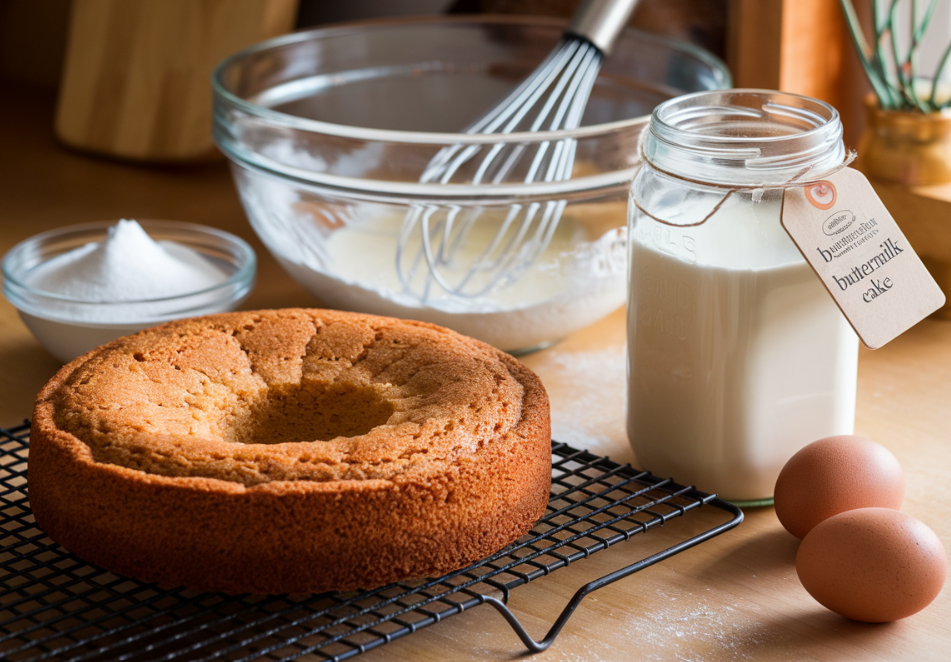Buttermilk is often hailed as a secret ingredient in baking, especially when it comes to cakes. Its unique properties elevate the texture, flavor, and overall quality of baked goods. Whether you’re an experienced baker or a novice, understanding the role of buttermilk can help you take your cakes to the next level.
What is Buttermilk?
Definition
Buttermilk, as we know it today, is a fermented dairy product. Traditionally, it was the liquid left behind after churning butter. Modern buttermilk, however, is cultured with lactic acid bacteria, giving it a tangy flavor and slightly thick consistency.
Key Characteristics
- Acidity: The lactic acid in buttermilk reacts with other ingredients, enhancing the baking process.
- Texture: Slightly thicker than milk but not as dense as cream.
- Flavor: Tangy and mildly sour, complementing the sweetness in baked goods.
Why It’s a Baking Staple
Buttermilk’s unique balance of acidity and creaminess makes it indispensable in baking. According to The Purpose of Buttermilk in Baking, it’s particularly valued for its ability to tenderize and leaven cakes.
For more simple yet effective recipes, check out What Foods Have 5 Ingredients or Less.
How Does Buttermilk Affect Cakes?
Buttermilk plays several critical roles in cake baking:
1. Tenderizes the Cake
- Acidic Reaction: The acidity in buttermilk helps break down gluten, resulting in a soft and tender crumb.
- Enhanced Texture: Cakes made with buttermilk often feel lighter and more delicate.
2. Adds Moisture
- The higher water content in buttermilk hydrates the batter, preventing dryness and ensuring a moist texture.
- Unlike milk, its consistency provides creaminess without adding heaviness.
3. Boosts Leavening
- Buttermilk reacts with baking soda or baking powder, producing carbon dioxide bubbles.
- This reaction causes the cake to rise, creating a fluffy and airy structure.
4. Enhances Flavor
- Adds a tangy undertone that balances the sweetness in cakes.
- Works particularly well in chocolate and spice cakes, amplifying their richness.
For more insights into the science of cake baking, explore Why Use Buttermilk in Cake.
Comparing Buttermilk with Other Dairy Products
1. Buttermilk vs. Milk
- Acidity: Milk lacks the acidic properties of buttermilk, making it less effective for tenderizing and leavening.
- Texture: Cakes made with milk may feel denser unless acid (e.g., vinegar or lemon juice) is added.
2. Buttermilk vs. Yogurt
- Acidity and Consistency: Yogurt is thicker and may need dilution to match buttermilk’s texture.
- Flavor: Both add tanginess, but yogurt is more pronounced in its tartness.
3. Buttermilk vs. Sour Cream
- Fat Content: Sour cream has higher fat, leading to a richer, denser cake.
- Usage: Often used in recipes where richness is prioritized over lightness.
Each substitution alters the cake slightly, so choose based on your desired result.
Recipes That Shine with Buttermilk
Buttermilk works wonders in various cake recipes, from classics to modern creations. Here are a few must-try options:
- Classic Buttermilk Pound Cake
- Dense yet tender, with a fine crumb and subtle tang.
- Chocolate Buttermilk Cake
- The acidity of buttermilk enhances the chocolate’s depth, making it richer and more intense.
- Buttermilk Vanilla Layer Cake
- A moist, flavorful option perfect for birthdays and celebrations.
- Red Velvet Cake
- Buttermilk is essential for achieving its signature soft texture and slight tang.
For easy-to-make recipes with buttermilk, visit What Chef Cooks with 5 Ingredients.
How to Substitute Buttermilk in Cakes
If you’re out of buttermilk, don’t worry! There are several substitutes you can use:
1. DIY Buttermilk Substitute
- Mix 1 cup of milk with 1 tablespoon of lemon juice or vinegar. Let it sit for 5–10 minutes until it curdles slightly.
2. Use Yogurt
- Dilute plain yogurt with water or milk to achieve a buttermilk-like consistency.
3. Opt for Kefir
- Kefir, a fermented dairy drink, is an excellent one-to-one substitute for buttermilk.
Tips for Success
- Use substitutes immediately to maximize their reaction with leavening agents.
- Adjust the baking soda or powder slightly if using thicker alternatives like yogurt or sour cream.
FAQs About Buttermilk in Cakes
Why does buttermilk make cakes tender?
The acid in buttermilk weakens gluten formation, resulting in a softer and more delicate texture.
Can I use regular milk instead of buttermilk?
Yes, but you’ll need to add an acid (like vinegar or lemon juice) to mimic the effects of buttermilk.
What types of cakes benefit most from buttermilk?
Cakes requiring moistness and lightness, such as chocolate cake, red velvet, and pound cake, benefit significantly from buttermilk.
Does buttermilk add a sour taste to cakes?
Not at all! It enhances flavor subtly without overpowering the sweetness.
How should buttermilk be stored?
Keep it refrigerated and use it before the expiration date. For long-term storage, freeze it in small portions.
Conclusion
Buttermilk is an indispensable ingredient in cake baking, offering benefits that go far beyond flavor. Its acidity tenderizes the crumb, its moisture prevents dryness, and its reaction with leavening agents ensures cakes rise to perfection. From classic pound cakes to rich chocolate delights, buttermilk adds a unique touch that transforms ordinary cakes into extraordinary ones.
For more ideas on baking and meal prep, explore What Is the Cheapest Meal You Can Make. The next time you’re baking a cake, don’t hesitate to include buttermilk—it’s the ingredient that makes all the difference!


14 thoughts on “What Does Buttermilk Do in Cakes?”